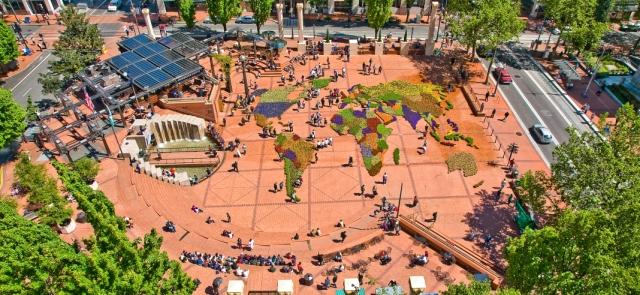This is part five of a series of blog posts about building community wealth in Santa Cruz. Read the previous post here.
As we learned earlier in this series from the concept of the eight forms of capital, there are valuable and important forms of capital beyond finance and money. How can communities collectively grow their social and cultural capital for the benefit of all residents and visitors?
In Santa Cruz, folks are organizing to try and save a parking lot in downtown from being converted into a multi-level parking garage. The parking lot in question is transformed weekly into a vibrant marketplace on Wednesdays when the Santa Cruz Farmers Market takes place. Beyond simply preventing the building of the parking garage, a group of folks called the Downtown Commons Associates are advocating that this parking lot be converted into a permanent community commons.
We wrote about this initiative earlier this year after Mark Lakeman visited Santa Cruz. During his visit, Lakeman spoke at an event titled “Imagining the Downtown Commons,” led a workshop that we hosted, and spoke with students at UCSC. The article provides some helpful background about this Downtown Commons project, public placemaking, and some of the successful projects that have taken place in Portland, OR, where Mark Lakeman lives and works.

For some recent updates about this project, we connected with John Hall, Research Professor of Sociology at UC Santa Cruz and UC Davis. We asked him to share why downtown Santa Cruz needs a commons. He writes:
“We need to build on the success of the Downtown Farmers’ Market, held on city parking lot 4, by changing its parking-lot quarters into a permanent plaza. Why? To create a beautiful tree-lined community space where people can gather to talk, play, meet friends, and enjoy other community events. This parking lot is the last, best community space for a public commons in downtown Santa Cruz.
“We need to act now because there is a political move to build a six- or 7-story parking garage and move the Farmers’ Market to a less desirable location. The market is a magnet for community and a commons will help build that community. Creating a Downtown Commons on lot 4 can reverse Joni Mitchell’s lament – unpaving the parking lot will create a little more paradise.”
Hall also shared some next steps, including how folks can get involved with the initiative. He writes:
“First, we need to convince the City Council not to build a parking garage and library on parking lot 4. If a multi-use garage were built on parking lot 4, it would be lost forever as a location for the Commons. The Council’s decision will likely be made this fall, after the Council’s Library Subcommittee issues its report on where the Downtown Library should be located – renovated in its present location, or built in the proposed parking garage or elsewhere.
“There are three important things people can do. First, attend the Climate Strike march on September 27, which will arrive around 4pm at parking lot 4, the future “Green Commons.” Show your visible support on the very spot that will become our Commons.
“Second, get your name on the Downtown Commons Advocates email list by making a request to downtowncommonsadvocates[at]gmail[dot]com. We will keep you informed about contacting the members of the City Council, attending City Council meetings where the garage taking of the commons is discussed, and other ways you can help.
“Third, Like, Follow, and Share our Facebook page. We appreciate your support. Together, we have the power to make a Downtown Commons happen!”
We hope you can make it to the strike and march on September 27. Santa Cruz Permaculture will be hosting a booth there, and it will be an inspiring opportunity to hear from youth in the community and envision the future of the Downtown Commons.
In closing
We’ve covered a lot in this series of articles–anchor institutions and collaboratives, community owned housing and cooperatives, public banks, and community commons. We examined what it means to consider economics through a permaculture framework and what community wealth means and why it matters.
Clearly, there are many ways to support community wealth building, and many of the California-based examples we shared could be models for other communities to replicate and adapt.
We each have a unique role to play in considering how our economic choices, capacity, and various forms of capital can contribute to, as Ted Howard puts it, “a democratic economy that produces reliable outcomes – including job creation, equity, inclusion, economic stability, environmental resilience – as a natural consequence of the functioning of the local economy.”
What role might you play in advancing these efforts?
